“Global Digital Audio Workstation Market to reach a market value of USD 6.3 Billion by 2031 growing at a CAGR of 8.1%”
The Global Digital Audio Workstation Market size is expected to reach $6.3 billion by 2031, rising at a market growth of 8.1% CAGR during the forecast period.
Educational institutions increasingly incorporate DAWs into their curricula, teaching student’s essential skills in music production and sound engineering. Therefore, the music school segment is expected to capture 16% revenue share in the market by the year 2031. This segment's growth reflects the broader trend of digitalization in education, where practical, hands-on learning experiences with industry-standard software are crucial for training the next generation of musicians and audio professionals.
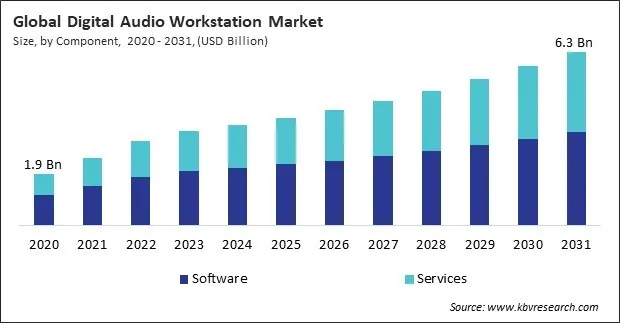
The major strategies followed by the market participants are Product Launches as the key developmental strategy to keep pace with the changing demands of end users. For instance, In July, 2024, Image-Line revealed FL Studio 2024. This update aims to enhance the functionality of FL Cloud by adding new plugins and collaborative features. FL Cloud now supports more advanced cloud-based collaboration, allowing users to share projects and work together in real-time with new tools designed to streamline the production process. Additionally, In September, 2024, Ableton announced the release of Live 12, the latest version of its popular digital audio workstation. This update introduces new features such as enhanced automation, improved sound design tools, and expanded device support, aimed at boosting creativity and workflow efficiency.
Based on the Analysis presented in the KBV Cardinal matrix; Apple, Inc. is the forerunner in the Digital Audio Workstation Market. In May, 2020, Apple unveiled the biggest update to Logic Pro X since its launch. This major update aims to enhance the functionality and user experience of Logic Pro X, a leading digital audio workstation. Companies such as Image-Line Software NV, Magix Software GmbH, PreSonus Audio Electronics, Inc. are some of the key innovators in Digital Audio Workstation Market.
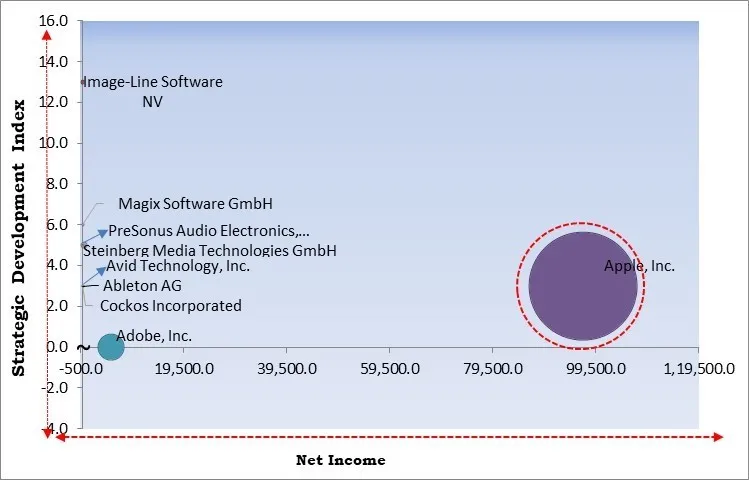
Advancements in technology have made high-quality recording equipment and software more affordable and accessible. Musicians and producers can now set up home studios with minimal investment, utilizing DAWs that offer professional-grade features. This accessibility encourages more individuals to explore music production independently, expanding the demand for DAW software. The rise of independent artists has been fuelled by a shift in the music industry towards self-production and distribution. Therefore, the increasing adoption of home studios and independent music production drives the market's growth.
The global music industry has grown substantially, driven by the proliferation of streaming services, digital downloads, and live events. This increased consumption creates a higher demand for new music, prompting more individuals to enter production. As the music industry expands, so does the need for DAWs, essential music creation and production tools. According to the International Federation of the Phonographic Industry (IFPI), 2023, global recorded music revenues grew by 10.2%. This was the ninth consecutive year of global growth. Revenues increased in every region. Thus, the growth of the global music industry and the increasing number of music producers are propelling the market's growth.
Professional-grade DAW software, such as Pro Tools, Logic Pro, or Cubase, often has a hefty price tag. These advanced programs offer many features, plugins, and tools necessary for high-quality music production, but their cost can be prohibitive. For instance, a single license for professional DAW software can range from several hundred to over a thousand dollars. Users often need to invest in high-performance hardware to utilize DAW software fully. This includes powerful computers with fast processors, ample RAM, and large storage capacities. Thus, the high initial software and hardware costs drive the market's growth.
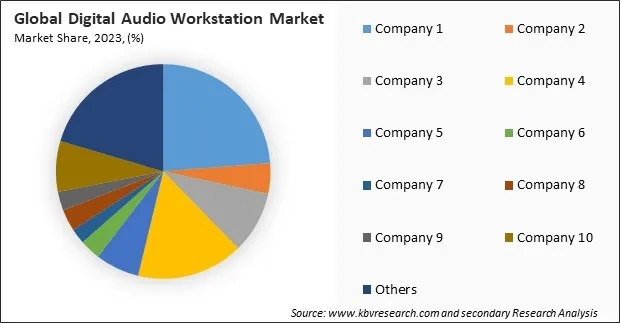
The leading players in the market are competing with diverse innovative offerings to remain competitive in the market. The above illustration shows the percentage of revenue shared by some of the leading companies in the market. The leading players of the market are adopting various strategies in order to cater demand coming from the different industries. The key developmental strategies in the market are Product Launches and Product Expansions.


Based on component, the market is divided into software and services. In 2023, the software segment garnered 57% revenue share in the market. This dominance can be attributed to the proliferation of user-friendly DAW software that caters to a wide range of users, from amateur musicians to professional sound engineers. The software segment includes various applications that offer functionalities like audio recording, mixing, editing, and mastering.
On the basis of operating system, the market is segmented into MAC, windows, android, and others. The windows segment recorded 47% revenue share in the market in 2023. This dominance can be attributed to the widespread use of Windows operating systems in home studios and professional settings. Many DAW software applications are optimized for Windows, offering many features that appeal to diverse users, including music producers, sound designers, and content creators.
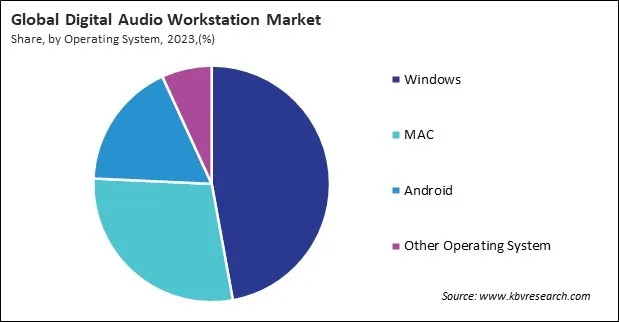
By end use, the market is categorized into professional audio engineers and mixers, electronic musicians, music studios, music schools, broadcasting and media companies, game developers. and others. The music studios segment procured 19% revenue share in the digital audio workstation market in 2023. Music studios are equipped with state-of-the-art technology and often rely on DAWs to facilitate everything from recording to mastering.
Free Valuable Insights: Global Digital Audio Workstation Market size to reach USD 6.3 Billion by 2031
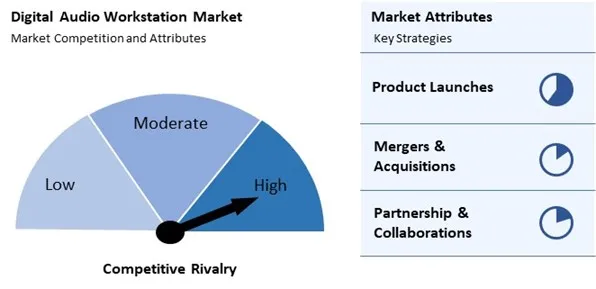
The Digital Audio Workstation (DAW) market is highly competitive, with key players dominating and emerging alternatives gaining popularity. Competition is driven by pricing, features, ease of use, and hardware integration. Companies target various segments, from professionals to hobbyists, and are increasingly adopting subscription models to enhance customer retention. Innovation in features and flexibility continues to shape the market landscape.
Region-wise, the market is analyzed across North America, Europe, Asia Pacific, and LAMEA. In 2023, the North America region witnessed 35% revenue share in the market. This can be attributed to the region's robust music and entertainment industry, where advanced audio production techniques are essential. The presence of major software developers and a strong music production culture contribute to the high demand for DAWs.
| Report Attribute | Details |
|---|---|
| Market size value in 2023 | USD 3.5 Billion |
| Market size forecast in 2031 | USD 6.3 Billion |
| Base Year | 2023 |
| Historical Period | 2020 to 2022 |
| Forecast Period | 2024 to 2031 |
| Revenue Growth Rate | CAGR of 8.1% from 2024 to 2031 |
| Number of Pages | 257 |
| Number of Tables | 393 |
| Report coverage | Market Trends, Revenue Estimation and Forecast, Segmentation Analysis, Regional and Country Breakdown, Competitive Landscape, Market Share Analysis, Porter’s 5 Forces Analysis, Company Profiling, Companies Strategic Developments, SWOT Analysis, Winning Imperatives |
| Segments covered | Component, End Use, Operating System, Region |
| Country scope |
|
| Companies Included | Apple, Inc., Adobe, Inc., Avid Technology, Inc. (STG Partners, LLC), Image-Line Software NV (FL Studio), Steinberg Media Technologies GmbH (Yamaha Corporation), Native Instruments GmbH, Magix Software GmbH, PreSonus Audio Electronics, Inc. (Fender Musical Instruments Corporation), Cockos Incorporated, Ableton AG |
By Component
By End Use
By Operating System
By Geography
This Market size is expected to reach $6.3 billion by 2031.
Increasing Adoption of Home Studios and Independent Music Production are driving the Market in coming years, however, High Initial Costs of Software and Hardware restraints the growth of the Market.
Apple, Inc., Adobe, Inc., Avid Technology, Inc. (STG Partners, LLC), Image-Line Software NV (FL Studio), Steinberg Media Technologies GmbH (Yamaha Corporation), Native Instruments GmbH, Magix Software GmbH, PreSonus Audio Electronics, Inc. (Fender Musical Instruments Corporation), Cockos Incorporated, Ableton AG
The expected CAGR of this Market is 8.1% from 2024 to 2031.
The Professional Audio Engineers & Mixers market dominated the Market by End Use in 2023; thereby, achieving a market value of $1.3 billion by 2031.
The North America region dominated the Market by Region in 2023; thereby, achieving a market value of $2.1 billion by 2031.
Our team of dedicated experts can provide you with attractive expansion opportunities for your business.
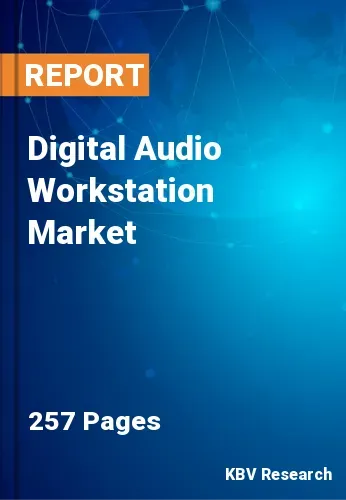
 Drivers
Drivers
 Restraints
Restraints
 Opportunities
Opportunities
 Challenges
Challenges
